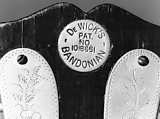Banjo-form Mandolin called a "Bandonian"
Not on view
In 1912, Brooklyn music teacher and banjo maker William De Wick was assigned a patent for his Bandonian (patent number 1018651), a round-body variation of a mandolin. By the first decade of the 20th century the mandolin had become widely popular across America, primarily through the successful marketing efforts of the Gibson Mandolin-Guitar Company. At the same time, the decrease in popularity of the five-string banjo led to the introduction of other types of banjos, including the four-string tenor banjo, the banjo uke, and the banjo mandolin, which combined an eight-string mandolin neck with a banjo rim and skin membrane. Although first patented in 1882, the banjo mandolin became popular in the early 1900s because it enabled mandolin players to produce banjo-like sounds without changing their playing technique. De Wick's Bandonian is a variant of the banjo mandolin, with a wood soundboard substituting for the stretched-skin banjo head. (Peter Szego, 2020)
This image cannot be enlarged, viewed at full screen, or downloaded.
This artwork is meant to be viewed from right to left. Scroll left to view more.




